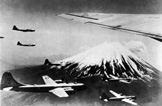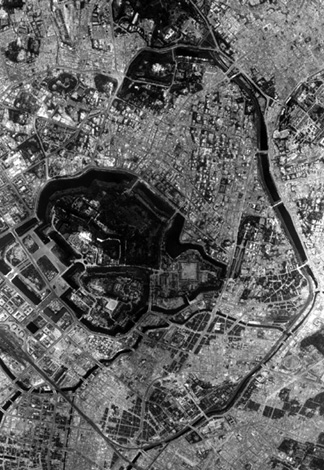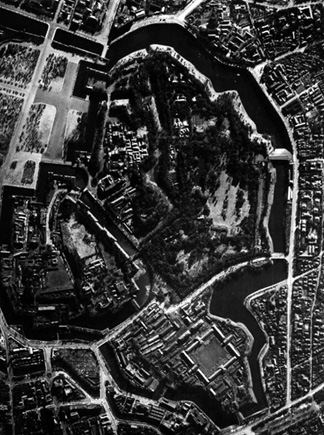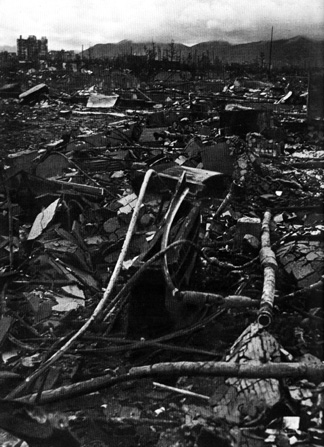|
Saipan: The |
||||||||||||
 |
||||||||||||
 |
||||||||||||
| This letter was written by Lieutenant F. H. "Pete" Reed to his parents, telling of his post-armistice flight over Tokyo, 28 August 1945 where his crew’s mission was to drop provisions to the Prisoner of War Camp at Kawasaki. Lt. Reed, and his crew, had been stationed on Saipan since October 1944.
This information has been provided courtesy of the Dearest Mom & Dad: I cannot possibly describe to you the adventure I had yesterday! I want to say so much, to describe so much, to let you know and realize so much. But, I cannot do it! I cannot grasp all I saw myself! If I could only make you feel the way I felt. But you couldn't! It doesn't mean that much to you! You know the war is over and that Tokyo, Kawasaki, Yokohama, etc., have been terribly burned and bombed, but it doesn't go any farther. You know that we hit targets in the Tokyo area, and that Tokyo and the area around it symbolizes the toughest target area to B-29 crewmen. But, do you really comprehend? You know our prisoners of war are there and that we dropped supplies to them But can you appreciate the feeling we got and what we saw, when we found the camp and dropped the supplies So I'll just tell what I did, and for ever more realize how much it meant to me. We took off on Tuesday morning at 0900 to drop drums of supplies (attached to parachutes) to PWs. Our camp was known to be in Kawasaki, (a sort of southern suburb of Tokyo), separated by a river, though it had never been seen or photographed. It was supposed to be in an area that had been burned badly and we were skeptical. We came into Tokyo Bay at about 5000 feet, at 1500 hours. The sun was beaming down, and we could see the fleet scattered all over Sagami Bay and some in Tokyo Bay already. F6Fs were flying around, and some F4As. We went up the Bay on the east side, drinking all the country-side in (indescribably beautiful), and noticing all the airfields, and planes sitting on them like a girl left waiting at the church. |
||||||||||||
| And finally we came opposite Kawasaki, and the mouth of the big river that runs between it and Tokyo and empties into the Bay. We turned toward it, and began looking. What desolation! - - Acres and acres of nothing but a rusty looking soil and ashy rubbish, marked by the faint lines where walls had once stood. Now and then a few square blocks stood unscathed, but only serving to impress one with the total devastation. Some railways were in operation, as I saw an inter-urban train like the S.P. trains in California running through the ruins, and all heads were outside the windows and looking at us. The highways were OK; and looked beautiful, and quite a bit of auto traffic was apparent, considering the destruction. But then for the world's third largest city and its environs I guess it wasn't too much, even if they were in ruins. |
||||||||||||
|
||||||||||||
| All of a sudden the bombardier picked out the PW camp. It was a two-story building with yellow pointed roofs, built in a square, with a large open compound or patio in the center. ON one side was a large field bounded by a highway, and on the other side a jam-packed area of small houses that somehow had escaped the fire. There were the following signs on the roofs of the camp: PW. NEWS? NEWS? COME AND GET US, THANK YOU. The roof was crammed, the top windows jammed and the courtyard was full of prisoners all waving, gesticulating , delirious in their efforts to tell us how happy they were. We dropped the supplies in a field nearby; and the boys were evidently free to get outside of the compound, for they ran after them like mad. Some of the chutes failed to open, and it is a good thing we did drop them in the field, for the drums would have killed our own prisoners. Some did hit a Jap home on our second run, and plummeted right on through. We also noticed another building on the waterfront, a two-or three-story warehouse, that had the following writing or printing on the sides and top: AUSTRALIANS, TAKE US HOME, THREE CHEERS US NAVY. What a lump in my throat. As I say, I cannot describe my feelings. |
||||||||||||
| Then we went up and flew over the Emperor's Palace, and even out to our old Nemesis of a target, the one I have told you about so often. We were flying at between 500 and 1000 feet! Tokyo is dead. Just acres of rusty looking ashes; and in the industrial areas, twisted, rusted gutted factories of all types. Now and then an untouched square of blocks, just to set off the contrast. Street-cars burned up, autos in parking lots burned, big government buildings like the Civic Center in San Francisco that looked unscathed, but with scorched markings, some worse than others. The down-town district of modern many-storied buildings reminded one of New York or San Francisco except not so tall. But to fly right over it! Everything flat as a pancake between the cement buildings, again that rusty, ashy looking dreariness, a close look showing that the big buildings still standing are gutted, burned out inside for the most part. |
||||||||||||
|
||||||||||||
| Althought there is a little traffic, the city is literally dead. The Emperor's Palace grounds are in fair condition, though some buildings have been flattened, and others damaged. We flew on toward Fuji, indescribably beautiful in the distance, and found our aircraft plant beyond the outskirts of the city, totally demolished! Again the countryside so beautiful I cannot attempt to portray it. So neat. So compact. Such wonderful colors. |
||||||||||||
| Back to the Big City: people walking around in some districts look up at us; again some bicycles; some motor transportation; but mostly pedestrians, to whom the surrounding devastation gave an utterly dazed appearance.
The sky was full of Navy fighters and B-29's (between 100 to 1000 feet) going every which way as they took in their sightseeing, and gave themselves and the poor Japs a close-up of each other. Back to the PW camp for a final buzz job, then out over Tokyo Bay and down to the Yokosuka Naval Base, - destruction all along the waterfront; oil refineries demolished. I even saw hundreds of Japs out in the shallow water of the Bay, and it looked like they were planting rice! What could it have been? Many airfields, all resembling Hamilton Field, some with planes shot up, others untouched; hangars burned up, desolation supreme. Over the big Naval Base at the southern end of the Bay we saw a Jap battle wagon sitting useless, and a sub over-turned and rusting; destruction, utter and universal. |
||||||||||||
|
||||||||||||
| The point towards Atsugi Airfield was our next heading. We flew nearly over it, and then turned left out over Sagami Bay, and buzzed the Fleet at 1000 feet, finally heading for Iwo, where we landed at about 2200. We had spent 1 hour and 45 minutes dropping our supplies and sightseeing, the biggest thrill of my life!
We spent the night at Iwo, and I flew back this morning. It may well be my last mission, though there is a possibility of a few more. (It made 30 for me.) I'm pooped out, exhausted and thrilled beyond words! Love, Pete P. S. No matter what they say, the biggest FACTOR in Japan's defeat is the B-29! Published In The BREEZE@. Vol. II, No. 8. P. 1-3. September 10, 1945. Pete Reed enrolled in Principia College in 1946. End of The Thirtieth Mission Story Click here to go to the companion Fourteenth Mission Story Home - Contact Us - Cold War Hist. - 91st SRS Hist. - Stardust 40 Mission Story |
||||||||||||


